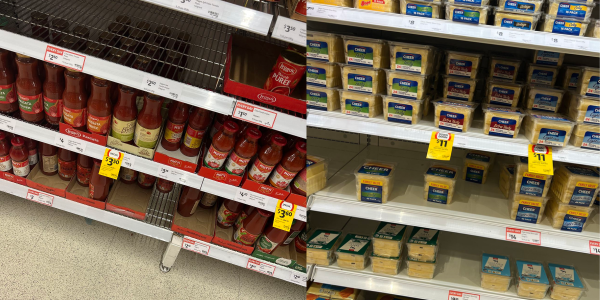Supermarket Secrets Exposed: Uncover the Hidden Locations of the Most Affordable Items
By
VanessaC
- Replies 7
Have you ever found yourself standing in an aisle at your local supermarket, wondering why the same product fills the top, middle, and bottom shelves and why they’re all priced differently?
It turns out that there’s a method to this–supermarkets carefully research customer behaviour and employ tactics to encourage shoppers to overspend.
Fortunately, with a bit of knowledge and savvy shopping, you can outsmart these strategies and save yourself some hard-earned money.
According to reports, supermarkets treat their shelves like rental spaces, with the most expensive ‘rent’ being the middle shelves (or customer’s eye-level).
That’s where you’ll often find attractive displays with yellow sale tags, carefully designed to catch the customer’s eye and convince them they’re getting the best bargain.
But for the real bargains, you’ll have to drop your gaze to the very bottom shelf. That’s where most supermarkets keep their home brands that are already so low in price, their regular prices are cheaper than the sales prices of premium brands.
A few examples found at Coles is a 24-slice pack of Cheer cheese is on sale for $11, down its regular price of $12.50. But when you look at the lower shelf, you’ll see the Coles brand in the same size for just $9.30.
In the images below, Leggo’s Passata is on sale for $3.50, usually $4.50, while the store brand on the lowest shelf costs just $2.
Red Tractor instant oats can also be found on sale for $4.75, down from its original price of $5.30, but on the bottom part of the shelf, you’ll find a 1.8-kilo bag of rolled oats from Coles for just $3.10.
Lastly, Captain’s Table water crackers are selling for $1.80, but the generic brand found on the bottom shelf costs just 95 cents.
Before going to the supermarket, take a look at what’s on your list and identify the items that you don’t mind trying different brands for. Then, take a tour around the store and focus on the items on the lower shelves. You’ll be surprised at the savings you’ll make!
By making this practice a habit, you can save yourself up to $50 a month!
Also, don’t forget to look at the unit price of the product you’re comparing as it shows the price of the product per unit of measurement, such as per litre, gram, or kilogram.
By taking an item’s unit price into consideration, you can easily compare prices of similar products, even if they come in different sizes, brands, or packaging.
Unit prices are calculated to the nearest dollar and cent, making it easy for you to compare and find the product with the most value.
Here’s an article with more information on unit pricing.
 Share this article with your friends and family to help them save some dollars on their grocery bills!
Share this article with your friends and family to help them save some dollars on their grocery bills!
Let us know if you have other tips on how to save on groceries in the comments below.
It turns out that there’s a method to this–supermarkets carefully research customer behaviour and employ tactics to encourage shoppers to overspend.
Fortunately, with a bit of knowledge and savvy shopping, you can outsmart these strategies and save yourself some hard-earned money.
According to reports, supermarkets treat their shelves like rental spaces, with the most expensive ‘rent’ being the middle shelves (or customer’s eye-level).
That’s where you’ll often find attractive displays with yellow sale tags, carefully designed to catch the customer’s eye and convince them they’re getting the best bargain.
But for the real bargains, you’ll have to drop your gaze to the very bottom shelf. That’s where most supermarkets keep their home brands that are already so low in price, their regular prices are cheaper than the sales prices of premium brands.
A few examples found at Coles is a 24-slice pack of Cheer cheese is on sale for $11, down its regular price of $12.50. But when you look at the lower shelf, you’ll see the Coles brand in the same size for just $9.30.
In the images below, Leggo’s Passata is on sale for $3.50, usually $4.50, while the store brand on the lowest shelf costs just $2.
Red Tractor instant oats can also be found on sale for $4.75, down from its original price of $5.30, but on the bottom part of the shelf, you’ll find a 1.8-kilo bag of rolled oats from Coles for just $3.10.
Lastly, Captain’s Table water crackers are selling for $1.80, but the generic brand found on the bottom shelf costs just 95 cents.
Before going to the supermarket, take a look at what’s on your list and identify the items that you don’t mind trying different brands for. Then, take a tour around the store and focus on the items on the lower shelves. You’ll be surprised at the savings you’ll make!
By making this practice a habit, you can save yourself up to $50 a month!
Also, don’t forget to look at the unit price of the product you’re comparing as it shows the price of the product per unit of measurement, such as per litre, gram, or kilogram.
By taking an item’s unit price into consideration, you can easily compare prices of similar products, even if they come in different sizes, brands, or packaging.
Unit prices are calculated to the nearest dollar and cent, making it easy for you to compare and find the product with the most value.
Here’s an article with more information on unit pricing.
Key Takeaways
- Supermarkets utilise a strategic product placement approach to encourage customers towards more expensive products.
- More expensive products and brands are often placed in the middle shelves, also known as the customers’ eye lines, as this space is more expensive to 'rent'.
- Cheaper products, often the supermarket's own brands, are typically found on the bottom shelves - their regular prices are often cheaper than the sale prices of premium brands.
- Customers can potentially save up to $50 a month by making a habit of checking the bottom shelves for alternative brands.
Let us know if you have other tips on how to save on groceries in the comments below.









